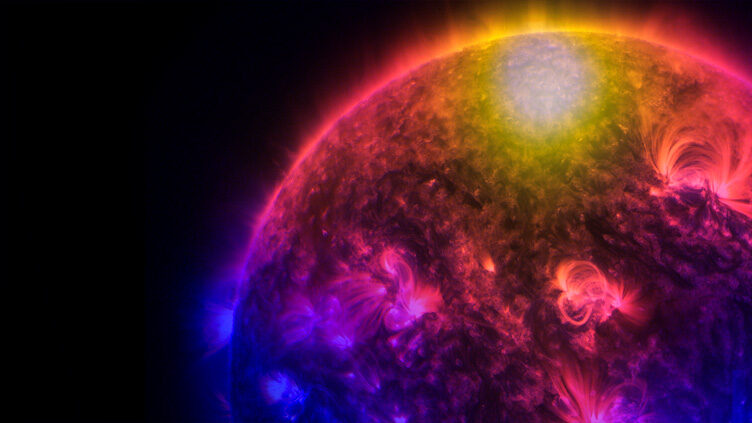The Sun’s polar regions were the most active emitting high energy radiation during the previous solar maximum, an imbalance yet to be explained, and reported for the first time in a study led by a researcher of the Institute of Astrophysics and Space Sciences (IA)
The Sun shines brightly in the visible light, but how does it look like at the highest energies of the electromagnetic radiation? The Sun’s picture taken in gamma rays is a deadly sight, luckily blinded by the Earth’s atmosphere and only seen from space. Each photon carries a billion times more energy than its ultraviolet sibling.
How does the Sun’s regular gamma rays emission vary with time? And is it possible to link it to the periods of violent events we witness on the surface of our star?
A study1, published today in The Astrophysical Journal, produced a compressed fourteen years movie of the Sun observed in gamma rays, a visualization tool which revealed that, contrary to the expected uniform distribution of these high energy photons, the solar disk can become brighter on the polar regions. This tendency for the Sun’s glow in the gamma rays to be dominant at the highest latitudes is evident during the peak of the solar activity, as could be seen in June of 2014.
“The study of gamma-ray emissions from the Sun represents a new window to investigate and understand the physical processes that happen in the atmosphere of our star. Maybe there are additional mechanisms generating gamma rays that go beyond the interaction of cosmic rays with the surface of the Sun.”
Bruno Arsioli
The study, led by Bruno Arsioli2, of the Institute of Astrophysics and Space Sciences (IA), in Portugal, and the Faculty of Sciences of the University of Lisbon (Ciências ULisboa), may contribute to the understanding of the yet unknown process that makes the Sun shine ten times brighter in gamma rays than physicists expected. It might as well inform space weather forecasts.
Plots presenting the solar emission of gamma rays of energies between 5 and 150 GeV per photon. In the plot to the left, the lighter colours (yellow and orange) represent the highest density of emissions of these high energy photons.
It is evident the tendency for this emission to occur on the polar regions, especially during the period of inversion of the signs of the solar magnetic field. This inversion is registered in the plot on the right by the crossing of the coloured bands that represent the strength of the magnetic field on the north and south poles. Credits: Arsioli e Orlando 2024 & NASA/SDO/Duberstein
Solar gamma rays are produced in our star’s halo and in solar flares, but also released from its surface. The latest were the focus of this study. “The Sun is stormed with close to light-speed particles coming from beyond our galaxy in all directions,” says Bruno Arsioli.
“These so-called cosmic rays are electrically charged and are deflected by the Sun’s magnetic fields. Those that interact with the solar atmosphere produce a shower of gamma rays”.
Scientists thought these showers had equal chances of being seen anywhere across the Sun’s disk. What this work suggests is that cosmic rays might interact with the Sun’s magnetic field and thus produce a gamma-ray distribution that is not uniform across all latitudes of our star.
“We demonstrated a strong correlation of the asymmetry in the solar gamma-ray emission in coincidence with the solar magnetic field flip, which has revealed a possible link among solar astronomy, particle physics, and plasma physics.”
Elena Orlando
“We also detected a difference in energy between the poles,” Bruno Arsioli adds. “In the south pole there is a surplus of emissions of higher energy, of photons with 20 to 150 gigaelectronvolts, while most of the less energetic photons come from the north pole.” Scientists haven’t yet an explanation for this asymmetry.
During the maximum of the solar activity cycle, it is evident that gamma rays are being radiated more often at higher latitudes. They were particularly concentrated on the solar poles in June of 2014, upon the reversal of the solar magnetic field. This is when the Sun’s magnetic field dipole swaps its two signs, a peculiar phenomenon that is known to happen at the peak of solar activity, once every eleven years.
“We have found results that challenge our current understanding of the Sun and its environment,” says Elena Orlando, of University of Trieste, INFN, and Stanford University, and co-author of this study. “We demonstrated a strong correlation of the asymmetry in the solar gamma-ray emission in coincidence with the solar magnetic field flip, which has revealed a possible link among solar astronomy, particle physics, and plasma physics.”

The data used came from 14 years of observations with the gamma rays satellite Fermi Large Area Telescope (Fermi-LAT), between August 2008 and January 2022. This period covered a full solar cycle, from a minimum to the next, with the peak in 2014. One of the challenges was to disentangle solar emissions from the numerous other sources of gamma rays in the background sky, crossed by the apparent trajectory of the Sun.
Bruno Arsioli and his colleague Elena Orlando produced a tool to integrate all the solar gamma-ray events within a window of the order of 400 to 700 days, and this window can slide across the 14-year period. Through this visualization (available in the media-kit below), the moments of polar excesses became clear, as well as the energy discrepancy between north and south.

“The study of gamma-ray emissions from the Sun represents a new window to investigate and understand the physical processes that happen in the atmosphere of our star,” says Arsioli. “What are the processes that create these excesses at the poles? Maybe there are additional mechanisms generating gamma rays that go beyond the interaction of cosmic rays with the surface of the Sun.”
Yet, if we stick to cosmic rays, they may work as a probe of the inner solar atmosphere. The analysis of these Fermi-LAT observations also motivates a new theoretical approach that should consider a more detailed description of the magnetic fields of the Sun.
“If it is settled that high energy emissions really carry information about the solar activity, then the next mission should be planned to provide real time data on gamma-ray emissions from the Sun”
Bruno Arsioli
The possible connection between the Sun’s production of gamma rays and its spectacular periods of more frequent solar flares and coronal mass ejections, and between these and the changes in the magnetic configuration of our star, may be an ingredient to improve the physical models that predict the solar activity. These are the basis of space weather forecasts, essential to protect instruments on satellites in space and telecommunications and other electronic infrastructures on Earth.
“In 2024 and the next year we will experience a new solar maximum, and another inversion of the Sun’s magnetic poles has already started. We expect by the end of 2025 to reassess if the inversion of the magnetic fields is followed by a surplus in the gamma rays emissions from the poles,” says Bruno Arsioli.
Elena Orlando adds: “We have found the key to unlock this mystery, which suggests the future directions that should be taken. It is fundamental that the Fermi telescope will operate and observe the Sun in the coming years.”
But the solar gamma rays are likely to have more to reveal and demand further attention. This study now published will strengthen the science case for the continuous monitoring of the Sun by the next generation of gamma rays space observatories.
“If it is settled that high energy emissions really carry information about the solar activity, then the next mission should be planned to provide real time data on gamma-ray emissions from the Sun,” says Arsioli.
- The article “Yet Another Sunshine Mystery: Unexpected Asymmetry in GeV Emission from the Solar Disk”, by Bruno Arsioli and Elena Orlando, was published today in The Astrophysical Journal (DOI:3847/1538-4357/ad1bd2). It was previously announced at the American Astronomical Society Press Conference by Elena Orlando, on 8 January 2024.
- Bruno Arsioli’s work has been possible through a research grant at the University of Trieste Department of Physics, and as a Marie Skłodowska-Curie Postdoctoral Fellow at the Institute of Astrophysics and Space Sciences (IA).
Contacts
Bruno Arsioli
Science Communication Group
Sérgio Pereira; Ricardo Cardoso Reis; Filipe Pires (coordination, Porto); João Retrê (coordination, Lisbon)


